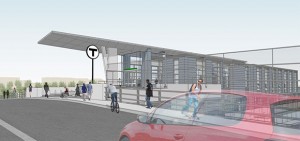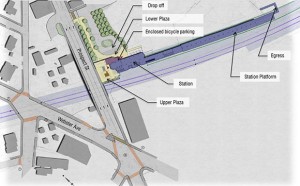 By William C. Shelton
By William C. Shelton
(The opinions and views expressed in the commentaries of The Somerville Times belong solely to the authors of those commentaries and do not reflect the views or opinions of The Somerville Times, its staff or publishers)
Boynton Yards will eventually produce more jobs and tax revenues than will a fully revitalized Union Square. For short money, the MBTA and the state could hasten that fate and make a critical investment in restoring the neighborhood to its former status as a center of commerce, employment, and connectivity, but without the unpleasant odors.

Current Union Square Station plans do not provide direct access to and from Boynton Yards.
In the 19th Century when Union Square was Somerville’s “downtown,” Boynton Yards was its industrial district. Originally a marsh, the advent of railroads made it attractive for industrial development.
If you’ve ever wondered why you can’t count seven of Somerville’s “seven hills,” or why there’s no hill in Cobble Hill, it’s because it became landfill. The former marsh became a site for rail yards, a glass factory, and three giant meatpacking plants which, along with their spin-off businesses, caused Somerville to be known as “the Chicago of the East.”
All of them dumped their sewage and wastes, into Millers River (called Willis Creek during colonial times), which flowed into the Charles River and formed part of the border between Somerville and Cambridge. The resulting stench and public health problems moved the Commonwealth to enact the first anti-pollution environmental laws in Massachusetts.
In his book, Inventing the Charles River, Karl Haglund reports that these laws, in turn, became precedents and models for environmental legislation throughout the U.S.
By 1874, the Commonwealth ordered the River filled. Nearby Prospect Hill, once as tall as the flag on the monument that presides over it, provided the soil.
The Nissenbaums tell me that they don’t have to dig far below their auto-recycling yard to find the River still rushing under it. Indeed, flowing underground water and inadequate storm sewers contribute to the flooding that periodically plagues Union Square.
The Somervision Comprehensive Plan and the Union Square Revitalization Plan designate Boynton Yards as a “transformative area” and anticipate infrastructure investments to improve its sewers, utilities, and streets. But one essential investment can be made now, and at a reasonable cost.
The Union Square Green Line station will be built on the north side of the rail bed that forms the boundary between the Square and Boynton Yards. It could and should include a headhouse on the Boynton Yards side of the tracks.
The additional cost of designing and building it would be small in comparison to the Union Square extension’s total cost. And building it now, as part of the station’s construction, would be much less costly than doing so separately in the near future, when it will inevitably be needed.
A Boynton Yards land rush is in its earliest stages, with developers already making offers to landowners. They understand that the neighborhood has more acreage than Union Square proper and will accommodate much higher building densities, with maximum height limits ranging from 75 to 135 feet.
Situated between the amenities offered by Inman Square and a revitalized Union Square, it will be an attractive site for office space. And attractive as well for research and development facilities, which provide municipalities with the highest tax returns and lowest traffic and public safety costs.
East Cambridge is increasingly built out for commercial uses, while demand for space proximate to MIT/Kendall Square’s R&D cluster continues to increase. The MBTA’s CT2 and 85 lines connect Boynton Yards to Kendall, while the Union Square Revitalization Plan promises that, “In a shorter timeframe, a transportation management agency (TMA) will be planned to provide shuttle service between Kendall Station, Boynton Yards, and the Union Square Green Line Station, thereby providing Red Line and Green Line connections to development in the Boynton Yards area.”
With a headhouse in Boynton Yards, the Green Line would also connect it directly to the Longwood medical district. One development group is already contemplating a quarter-billion-dollar life sciences campus with a Cambridge Street address, but almost all of the campus located within Boynton Yards, where it would create Somerville taxes and jobs.
Five years ago I wrote a column advocating construction of a second headhouse at the south end of Assembly Square’s Orange Line platform. I don’t imagine that I influenced the decision to build it. But I am certain that, had it not been built, we would not see piles being driven today for a 770,000 square-foot office building.
We can build a Green Line station with a second headhouse now, thereby hastening Boynton Yards development. Or we can do so later, pay more, and slow down that “transformative area’s” transformation. Doing the former is just common sense.
















Reader Comments